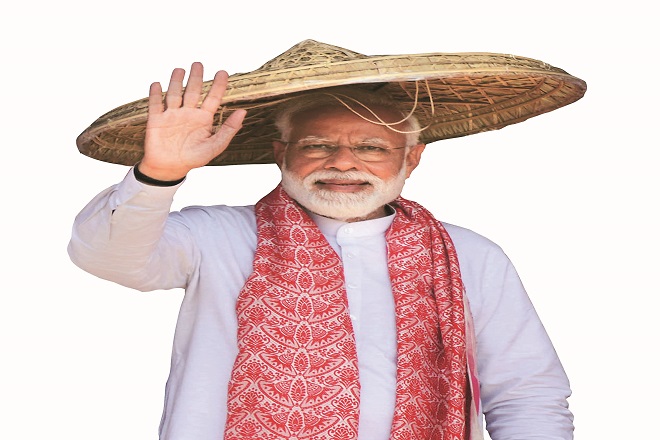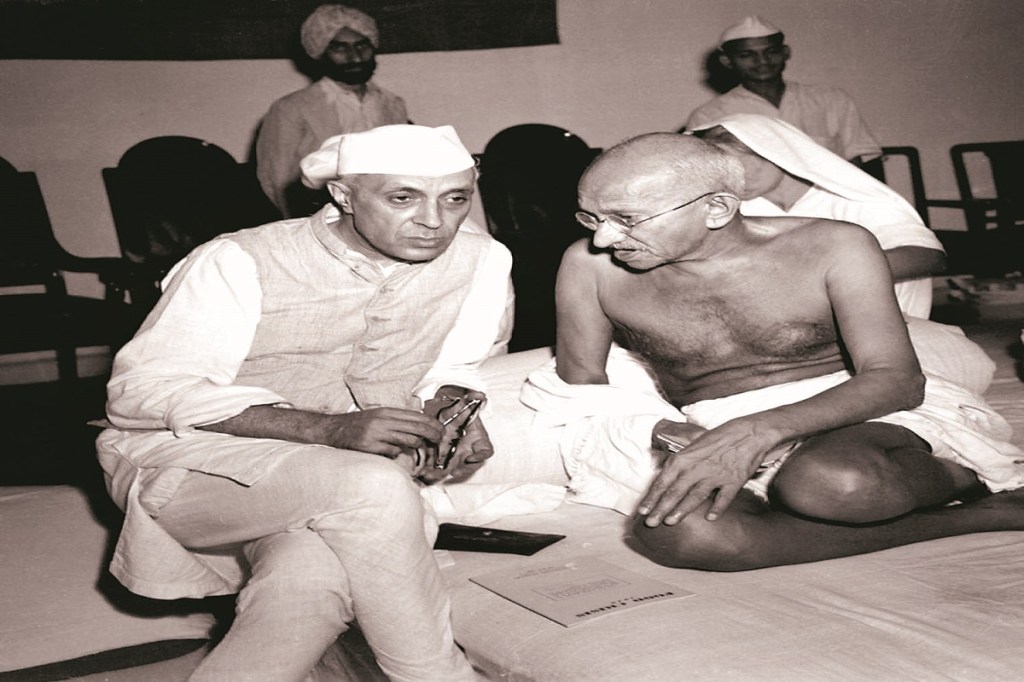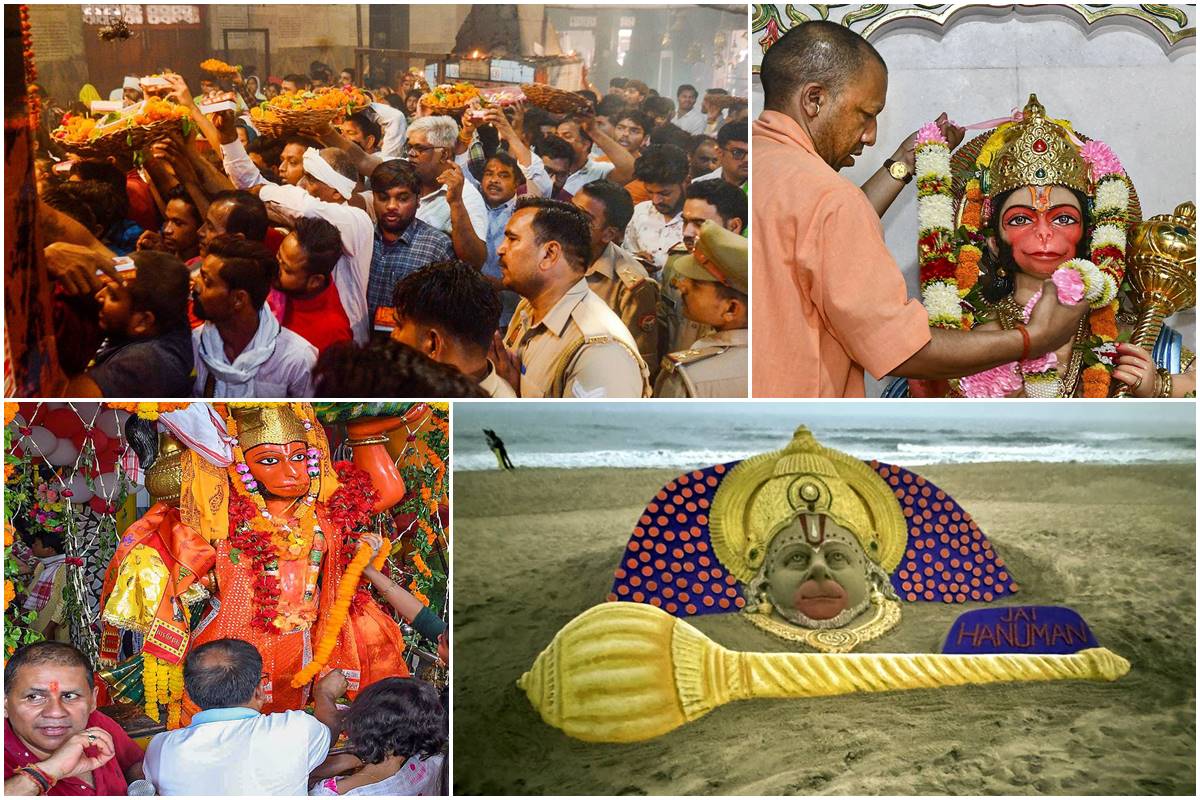Leg in a cast, rolling in a wheelchair, Bengal chief minister Mamata Banerjee rallied her election campaign in the heart of Kolkata despite an injury. A valiant and relentless electoral campaigner in spirit and soul, she forewarned her rivals on how “an injured tiger is far more dangerous”. Attesting this was her disarming trademark white cotton sari with a mono-coloured blue border and her signature hawai chappals—possibly, a preferred ‘uniform’ outfit and a force multiplier to resonate with the common man. Blue and white are Banerjee’s favourite colours and all government buildings in West Bengal are painted in the two shades.

Before the Lok Sabha election in 2019, too, the political slogan on her chappals, ‘Dilli jabe hawai choti (The chappal will go to Delhi)’, went viral. All this is relatable with Banerjee’s non-elite, ordinary social background and committed political career, with her sartorial style playing a major role in defining mass appeal. “Attire is a powerful visual means of communicating ideology, whether political, social or religious. From the communist values of simplicity, equality, frugality and solidarity, exemplified in the Mao suit, to the myriad of fashion protests by feminists such as French revolutionary women’s demand to wear trousers, the dress can symbolise ideological orthodoxy, as well as revolt,” says Nandita Abraham, professor and president, Pearl Academy, design college with five campuses pan India.
“Compared with the boxy Mao jacket, the well-fitted, fuss-free Nehru jacket clearly indicated what he stood for and has been adopted around the world by Pierre Cardin, the Beatles and even actor Sean Connery in the James Bond film Dr No. What people in positions of power wear creates both an impact on the people around them and at the same time communicates their agenda,” she says.




The politics of dressing has always been under scrutiny as it reckons with the past and the present, sometimes doubting the integrity and image of our favourite politicians. For instance, Banerjee’s dressing, according to Madhya Pradesh minister Narottam Mishra, is a façade of simple living, as the CBI questioned her nephew and TMC leader Abhishek Banerjee’s sister-in-law in a coal scam this year.
However, if some politicians are best known for their sartorial sense or the image they try to project, some have more often been criticised for asserting their style, even within the confines of their ‘uniforms’—saris, kurta-pyjamas, suits or dresses. In such cases, image consulting plays a crucial role, feels fashion, grooming and image consultant Yatan Ahluwalia. “Clothes and accessories create an image that connects with the culture, nationality and people. They are often used to build a patriotic or nationalist narrative as well. Politicians also have to dress by occasion.
Internationally, image management is a full-time engagement for world leaders and everything they wear and carry is well-planned and articulated. The idea behind image management with a leader is to build a connection with their audience,” says Gurugram-based Ahluwalia.
Personalised style
All through modern history, politicians across the world have chosen style statements that assert their philosophy or belief system. Sometimes it is so overpowering that it captures our collective imagination. Dressing is a medium of communication through which people in positions of power aim to evoke emotional response and connect at the grassroots and cultural level, says Antonio Maurizio Grioli, dean, school of fashion, Pearl Academy, adding that communication is one of the major beacons of social design, empowering faith, unity, integrity and reuniting purpose. “Starting from the political to cultural fabric, the role of signifying by colour, attire and style has helped to establish icon and stream ideologies. Over a chronological study, it would be very easy to decipher that leaders of politics, culture, etc, have defined faith and beliefs with the help of personal style,” says Grioli.
Most left-wing leaders (Chinese revolutionary Mao Tse-tung, Cuban politician Fidel Castro, Italian politico Benito Mussolini) choose khaki regimental attire, while dictators (German dictator Adolf Hitler, North Korea’s Kim Jong-il and his son Kim Jong-un) opt for military attire to assert their authority. Independent leaders go for a democratic style statement, exuding a more accepting perception. For instance, the Queen of England’s colourful skirt suits are indisputably stylish and are designed in shades of fuchsia, lemon and royal blue for royal engagements by designers Stewart Parvin and Angela Kelly. According to her daughter-in-law Sophie, the Countess of Wessex, and as quoted in the documentary, The Queen at 90, “She wears to ensure crowds can see her.”
Closer home, Mahatma Gandhi may have been seen as ‘indecently dressed’ during his movements abroad, but he nevertheless made a mark through his attire. Gandhi, who was always clad in a dhoti, was quite infamously labelled “the half-naked fakir” by Winston Churchill. “Gandhi’s humble and profoundly effective khadi attire symbolised humility and ahimsa,” says Sounak Sen Barat, creative head and founder, House of Three, a Bengaluru-based fashion design studio. “Jawaharlal Nehru’s suave jawahar coat (that is now rechristened Modi jacket), Maulana Azad’s fitted sherwanis and caps, Indira Gandhi’s handloom cottons and Rahul Gandhi’s more contemporary twist, replacing the jawahar waistcoat with a quilted Burberry bomber waistcoat, each had their own message to deliver,” says Barat, adding, “Politicians have a value system to uphold and their personal style is thoughtfully crafted to communicate those values. Conservatives dress conservatively, secular liberals add a touch of contemporary, stern right-wingers dress flamboyantly and assertively, using bold colours (reflecting a mix of arrogance, adamance and attention-seeking pomp and show), while dictators wear military uniform, which sends a message loud and clear.”
A politician dresses up either for tradition or to boost a certain image. Take, for instance, the well-groomed image of Prime Minister Narendra Modi, who always remains in the news for his styling, and has sometimes even received flak for it. Modi, who likes to localise his style to the places he visits, has often worn traditional Indian attire, business suits with apt headgear and colourful scarves. Campaigning for the general elections, he donned the traditional Assamese japi in north-eastern Assam. In Arunachal Pradesh, he wore dumuluk, a traditional headgear of the Adi tribe, while in Punjab, he opted for an elaborate pagdi. Author Nilanjan Mukhopadhyay in his book Narendra Modi: The Man. The Times writes about his “weakness for designer fountain pens”, adding that he “likes to wear premium designer watches”. Mukhopadhyay says his favourite brand is Movado, a Swiss luxury watch company.

Modi’s love for brands and marketing to strike a chord with young India’s aspirations has been pointed out by Congress MP Shashi Tharoor as well. In his book, The Paradoxical Prime Minister, Tharoor stitches a range of paradoxes to show how Modi, as a noble leader, acts effectively in the interests of countrymen or an autocratic interest in power to convert plural India into a Hindu Rashtra.
In 2015, Modi’s rather extravagant navy blue monogrammed bandhgala made a powerful statement during then US president Barack Obama’s visit to Delhi. It was painstakingly embroidered with his name ‘Narendra Damodardas Modi’ multiple times and was gifted by businessman Rameshkumar Bhikabhai from Gujarat. The suit—purchased for Rs 4.31 crore by Surat-based diamond trader Lalji Patel, owner, Dharmananda Diamond Company—also entered the Guinness World Records as “the most expensive suit sold at auction”. The money raised from the auction of the suit was earmarked for the Centre’s Clean Ganga mission.
Thanks to the bandhgala, though, Twitterati called Modi “a case of crazed self-obsession” and “height of narcissistic behaviour”. Congress leader Rahul Gandhi, too, accused him of heading a “suit-boot ki sarkar”, which worked only for the rich. In response, though, Gandhi’s Burberry jacket became a symbol for Congress’s corruption.
Images tweeted of the ‘Modi jacket’ gifted to South Korean President Moon Jae-in raised a Modi vs Nehru debate in 2018. Former Jammu & Kashmir chief minister Omar Abdullah tweeted: “It’s really nice of our PM to send these but could he not have sent them without changing the name? All my life I’ve known these jackets as Nehru jackets & now I find these ones have been labelled ‘Modi Jacket’. Clearly, nothing existed in India before 2014.” In a 2018 report published in a British daily, Modi jacket was subject to criticism over colour. However, the makers of the jacket confirmed the difference between the two. “Nehruji used to largely wear white and off-white jackets. He never wore colours. Modiji brought in colours and a new design,” said Gujarat-based Bipin Chauhan, managing director, JadeBlue Lifestyle India, the retailer of Modi jackets, in an interview with The Indian Express, adding that Modi popularised the jacket and took it to the masses, making it a style statement among corporates.
Conscious of their image and fan following, many political leaders make use of subtle dressing styles to connect with the common man. While some opt for a more personalised style using specific colours (often the colours of the flag as seen in the ties worn by Trump—mostly red or blue), things like religious identity (saffron for Hinduism, green for Islam), prints, patterns and accessories help them make a cultural connection (wearing a print from a region while addressing a rally). “Khadi in India is worn to connect with the people. Rahul Gandhi has worn shirts with jeans, which helps him connect with a younger audience, especially when he is sporting a young and lively image in a kurta-pyjama and sneakers visiting universities and colleges,” says Ahluwalia.

Sonia Gandhi, too, has been known for her dignified dressing sense from before she entered politics. Her love for khadi prints and traditional handloom weaves like Telia Rumal from Andhra Pradesh is clear from her various appearances, be it public gatherings or election campaigns. Priyanka Gandhi Vadra, too, is often seen in a crisp white shirt with black trousers that resonate with the capital’s cosmopolitan culture or a handloom sari that reminds one of her Indianness.

Understanding that saris resonate with the people of India, some women politicians, including the Gandhis, have created a signature style. “The Gandhi ladies will always wear certain kinds of saris—subtle, never too loud and very simple and understated,” says Ahluwalia.
MGR’s protege, the late J Jayalalithaa, was also admired, both as an actor and politician, in her pristine white sari with a black-and-red border that stands for Tamil Nadu’s ruling party AIADMK’s colours. Adorning her persona was a collection of 10,500 saris, 750 pairs of footwear, countless watches, jewellery and stylish high-collared coloured capes—a graceful combination with the sari—which were supposedly worn to cover her big body or hide some flaws. Minimalist traditional and ethnic wear, too, works well. Hina Rabbani Khar, former minister of foreign affairs of Pakistan, shows off her minimalistic fashion choice through her plain, straight-cut monotone kurtas and pants teamed with sunglasses and handbags. Former minister of food processing industries, Harsimrat Kaur Badal drapes a dupatta over her head and wears churidar-kurtas or salwar suits along with matching colourful jutties and accessories like Hermès or Tod’s bags.
The hair, too, becomes an accessory. A striking feature in former Indian prime minister Indira Gandhi’s persona was a streak of grey in her hairdo, done by Habib Ahmed, father of celebrity hair stylist Jawed Habib. Then there is Mayawati. Her look—diamond earrings, a dupatta slung around her neck and a bob cut—signifies pride in her cluster Dalit following.
Some politicians, however, don’t need styling tips. Their natural sense of style makes a statement and conveys a message. Like the iconic red rose pinned in Jawaharlal Nehru’s sherwani, Rajiv Gandhi’s modern and chic dressing in sneakers and sleeveless jackets, and Rahul Gandhi’s sleek version of Nehru jacket as compared to Modi’s in linen, silk, pastel shades, etc.

In yet another innovation, Delhi CM Arvind Kejriwal earned himself the moniker of ‘muffler man’, thanks to his trademark woollen scarf. His topi during the Jantar Mantar and Ram Leela Maidan protests also resonated with the common man. “Wearing the national dress has been a common practice. Some first ladies and women leaders cover their arms and legs while visiting the Middle East. Most politicians normally don’t follow fashion trends and like to keep their look understated, simple and fuss-free. However, sometimes a pen in the pocket, a tie pin, a brooch, pocket square and choice of footwear can make strong statements as well,” says Ahluwalia.
Fashion acumen
Politicians around the world are admired for their luxurious and even quirky fashion acumen. Justin Trudeau, the Prime Minister of Canada, often dons a tuxedo with multi-hued socks in a variety of prints. Vladimir Putin, the President of Russia, wears customised dark blue suits (Kiton and Brioni are his favourite brands) often paired with Valentino ties and shoes from John Lobb or Salvatore Ferragamo. He also often wears patent boots, cargoes or shades for outdoor activities.

While Theresa May, former prime minister of the UK, wears a mix of graphic designs and textured jackets, Barack Obama, former president of the US, adapts a chic and classy look in his tailored dark-hued suits from Chicago-based label Hart Schaffner Marx.

Hillary Clinton, too, is often known to choose pantsuits that make a bold statement—she wore a white pantsuit to Donald Trump’s presidential inauguration in 2017. According to news reports, Clinton’s choice of white was a subtle show of support to the historic women’s suffrage movement.
When it comes to Michelle Obama, the former first lady is quite fond of India-born designers, especially Naeem Khan and Bibhu Mohapatra. Khan designed her gown for a state dinner in India in 2009, as well as many looks for her daughters Malia and Sasha. He also designed a dress made of fabric from Kashmir and embroidered with floral Indian motifs for a 2016 Cuba state dinner. Odisha-born New York-based designer Bibhu Mohapatra, too, designed a knee-length floral silk dress for her for a three-day visit to India in 2015.
More recently, Kamala Harris, Vice President of the US, was seen wearing sneakers during last year’s election campaign. In the process, she challenged outmoded concepts of femininity, especially in view of Theresa May’s leopard-print heels and Hillary Clinton’s kitten heels, with an underlying message of a woman in action.
In his book, Power Dressing: First Ladies, Women Politicians and Fashion, fashion journalist and author Robb Young offers an engaging perspective on the ability of style to influence the careers of women politicians and first ladies, ranging from such contemporary figures as Michelle Obama, Carla Bruni-Sarkozy, Angela Merkel and Queen Rania of Jordan to iconic women such as Eva Perón, Imelda Marcos and Margaret Thatcher. In his past media interactions, Young has emphasised how many female political leaders with their diverse wardrobes have made a strong statement and become powerful dressers compared with their male counterparts.

Fashion expresses political opinion through personality, prints and designs, say experts. “Fashion as a medium has the power to make political/social commentaries that can be hard-hitting and effective. Masses in general follow more fashion than art or literature as mediums and, hence, using it as a medium to send a message has been used time and again by designers and brands across countries in modern history,” says Barat of House of Three.
Breaking conventions
Debates often swirl around the attire of politicians, especially what they wear for parliament sessions. The Indian parliament dress code, for instance, is limited to sari, salwar-kameez, safari suit, kurta-pyjama, dhoti or lungi. However, Trinamool Congress MPs Mimi Chakraborty and Nusrat Jahan were in the spotlight for wearing western outfits to the Parliament in 2019. In 2008, Priyanka Gandhi Vadra wore trousers with a white shirt to Parliament to hear her brother Rahul Gandhi’s speech during the trust vote debate.
When a bastion of traditions fall, fashion claims its space and parliaments around the world have slowly begun to embrace change. In 2017, John Bercow, former Speaker of the House of Commons in the UK, said the convention requiring male MPs to wear jackets and ties should be abandoned.
The French parliament, on the other hand, has a dress code for MPs, requiring them to dress formally. It does not, however, have an official dress code policy. And yet French MP Jean-Luc Mélenchon sparked outrage in 2017 for refusing to wear a tie in parliament, claiming he did not want a dress code to be “imposed” on him. President Emmanuel Macron, on the other hand, is always immaculately dressed in a suit and tie.
When it comes to women politicians in parliament, there are a multitude of hurdles to overcome. In 2012, for instance, a colourful dress worn by Cécile Duflot, the former French minister of housing, triggered inappropriate remarks and whistles from her male counterparts. Donald Trump, too, had a fixation with the dress code and asked his female staff to ‘dress like women’.
But things are slowly beginning to change. Last year, Switzerland rolled back an ‘antiquated’ ban on women showing their shoulders in parliament and relaxed its clothing regulations for women to wear clothing which is appropriate to their official standing.
TALKING HEADS

What people in positions of power wear creates both an impact on the people around them and at the same time communicates their agenda
— Nandita Abraham, professor & president, Pearl Academy, a design college with five campuses pan India.

Conservatives dress conservatively, secular liberals add a touch of contemporary, while dictators wear military uniforms
— Sounak Sen Barat, creative head & founder, House of Three, a fashion design studio

Sometimes a pen in the pocket, a tie pin, a brooch, pocket square and choice of footwear can make strong statements as well
— Yatan Ahluwalia, a Gurugram-based fashion, grooming & image consultant



















